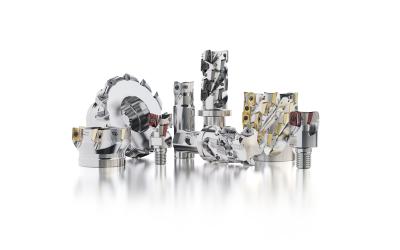
Manufacturers who look for versatility and precision in machining can pair up Seco Turbo 16 square shoulder milling cutters and Helical Turbo 16 milling cutters to reduce tooling inventories and costs. Both series offer high material removal rates in steel, stainless steel, cast iron, non-ferrous metals, superalloys and titanium. Scannable Data Matrix tags on cutter inserts store product and batch information that the new Seco Assistant app can read.
Turbo 16 square shoulder milling cutters: Optimized geometry and sustainable materials
Versatile Turbo 16 square shoulder milling cutters deliver outstanding results and process security with exceptional ramping capability. Optimized insert pocket angles enhance the cut and deliver outstanding surface finishes. With a high helix angle for smoother workpiece entry and exit, these cutters also feature efficient chip evacuation. Lower cutting forces reduce power consumption, tool wear and noise levels. "Manufacturers can achieve production efficiencies and enhance machining performance with these tools in virtually any material," said Michael Davies, Global Product Manager Square Shoulder Milling. Eco-friendly design uses corrosion-resistant steel with no nickel coating.
Helical Turbo 16 milling cutters: Aggressive material removal and smoother cuts
Next-generation Helical Turbo 16 milling cutters combine top performance with ease of use, benefiting from a comprehensive range of Seco insert grades and geometries for exceptional material removal rates (MRR) and extended tool life. Larger cuts and higher feeds reduce cycle times and speed up production, with optimized coolant channels, flutes and cutting rakes for stable machining and optimal chip formation. Helical Turbo 16 ensure that lead and helix inserts are not mixed up when using large radii. The replacement of nickel cutter coatings with PVD increases sustainability. "These features produce smoother cuts, increased tool life and process reliability for faster production. Helical Turbo 16 uses fewer inserts than equivalent tools that provide the same MRR" said Benoît Patriarca, Global Product Manager Helical Milling.
Contact Details
Related Glossary Terms
- coolant
coolant
Fluid that reduces temperature buildup at the tool/workpiece interface during machining. Normally takes the form of a liquid such as soluble or chemical mixtures (semisynthetic, synthetic) but can be pressurized air or other gas. Because of water’s ability to absorb great quantities of heat, it is widely used as a coolant and vehicle for various cutting compounds, with the water-to-compound ratio varying with the machining task. See cutting fluid; semisynthetic cutting fluid; soluble-oil cutting fluid; synthetic cutting fluid.
- flutes
flutes
Grooves and spaces in the body of a tool that permit chip removal from, and cutting-fluid application to, the point of cut.
- gang cutting ( milling)
gang cutting ( milling)
Machining with several cutters mounted on a single arbor, generally for simultaneous cutting.
- helix angle
helix angle
Angle that the tool’s leading edge makes with the plane of its centerline.
- milling
milling
Machining operation in which metal or other material is removed by applying power to a rotating cutter. In vertical milling, the cutting tool is mounted vertically on the spindle. In horizontal milling, the cutting tool is mounted horizontally, either directly on the spindle or on an arbor. Horizontal milling is further broken down into conventional milling, where the cutter rotates opposite the direction of feed, or “up” into the workpiece; and climb milling, where the cutter rotates in the direction of feed, or “down” into the workpiece. Milling operations include plane or surface milling, endmilling, facemilling, angle milling, form milling and profiling.
- physical vapor deposition ( PVD)
physical vapor deposition ( PVD)
Tool-coating process performed at low temperature (500° C), compared to chemical vapor deposition (1,000° C). Employs electric field to generate necessary heat for depositing coating on a tool’s surface. See CVD, chemical vapor deposition.
- superalloys
superalloys
Tough, difficult-to-machine alloys; includes Hastelloy, Inconel and Monel. Many are nickel-base metals.

